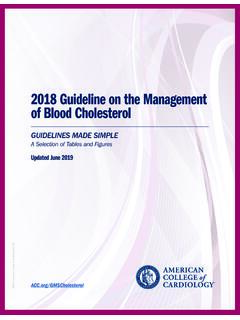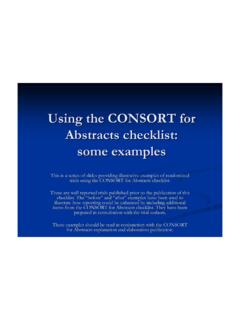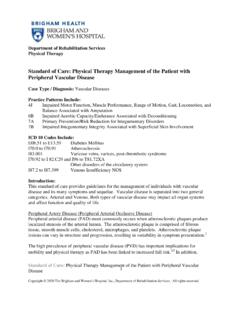Transcription of March 2010 - American College of Cardiology
1 Learn and LiveSMACC/AHA Pocket Guideline Based on the 2010 ACCF/AHA/AATS/ACR/ASA/SCA/SCAI/SIR/STS/S VM Guidelines for the Diagnosis and Management of Patients With Thoracic Aortic DiseaseMarch 2010iGuidelines for the Diagnosis and Management of Patients With Thoracic Aortic DiseaseMarch 2010 Writing CommitteeLoren F. Hiratzka, MD, ChairGeorge L. Bakris, MDJoshua A. Beckman, MD, MSRobert M. Bersin, MPH, MDVincent F. Carr, DODonald E. Casey, Jr, MD, MPH, MBAKim A. Eagle, MDLuke K. Hermann, MDEric M. Isselbacher, MDElla A. Kazerooni, MD, MSNicholas T. Kouchoukos, MDBruce W. Lytle, MDDianna M. Milewicz, MD, PhDDavid L. Reich, MDSouvik Sen, MD, MSJulie A. Shinn, RN, MA, CCRNLars G. Svensson, MD, PhDDavid M. Williams, MD 2010 American College of Cardiology Foundation and American Heart Association, following material was adapted from the 2010 ACCF/AHA/AATS/ACR/ASA/SCA/SCAI/SIR/STS/S VM Guidelines for the Diagnosis and Management of Patients With Thoracic Aortic Disease: Executive Summary (J Am Coll Cardiol 2010;55:1509 44).
2 This pocket guideline is available on the World Wide Web sites of the American College of Cardiology ( ) and the American Heart Association ( ).For copies of this document, please contact Elsevier Inc. Reprint Department, e-mail: phone: 212-633-3813; fax: : Multiple copies, modification, alteration, enhancement, and/or distribution of this document are not permitted without the express permission of the American College of Cardiology Foundation. Please contact Elsevier s permission department at Introduction ..62. Critical Issues ..103. Recommendations for Aortic Imaging Techniques to Determine the Presence and Progression of Thoracic Aortic Disease ..144. Recommendations for Genetic Syndromes ..185. Recommendations for Familial Thoracic Aortic Aneurysms and Dissections.
3 246. Recommendations for Bicuspid Aortic Valve and Associated Congenital Variants in Adults ..267. Recommendations for Estimation of Pretest Risk of Thoracic Aortic Dissection ..278. Initial Evaluation and Management of Acute Thoracic Aortic Disease..34 Recommendations for Screening Tests ..34 Recommendations for Diagnostic Imaging Studies ..35 Recommendations for Initial Management ..36 Recommendations for Definitive Management ..379. Recommendation for Surgical Intervention for Acute Thoracic Aortic Dissection ..412310. Recommendation for Intramural Hematoma Without Intimal Defect..4211. Recommendation for History and Physical Examination for Thoracic Aortic Disease ..4312. Recommendation for Medical Treatment of Patients With Thoracic Aortic Diseases.
4 Recommendations for Blood Pressure Control ..4413. Recommendations for Asymptomatic Patients With Ascending Aortic Aneurysm ..4614. Recommendation for Symptomatic Patients With Thoracic Aortic Aneurysm ..5015. Recommendations for Open Surgery for Ascending Aortic Aneurysm ..5116. Recommendations for Aortic Arch Aneurysms ..5217. Recommendations for Descending Thoracic Aorta and Thoracoabdominal Aortic Aneurysms ..5418. Recommendations for Counseling and Management of Chronic Aortic Diseases in Pregnancy ..5619. Recommendations for Aortic Arch and Thoracic Aortic Atheroma and Atheroembolic Disease ..584520. Periprocedural and Perioperative Management .. Recommendations for Brain Protection During Ascending Aortic and Transverse Aortic Arch Surgery.
5 Recommendations for Spinal Cord Protection During Descending Aortic Open Surgical and Endovascular Repairs ..6021. Recommendations for Surveillance of Thoracic Aortic Disease or Previously Repaired Patients ..6222. Recommendation for Employment and Lifestyle in Patients With Thoracic Aortic Disease ..6461. IntroductionThe term thoracic aortic disease encompasses a broad range of degenerative, structural, acquired, genetic-based, and traumatic disease states and pre-sentations. According to the Centers for Disease Control and Prevention death certificate data, dis-eases of the aorta and its branches account for 43 000 to 47 000 deaths annually in the United States. The precise number of deaths attributable to thorac-ic aortic diseases is unclear.
6 However, autopsy stud-ies suggest that the presentation of thoracic aortic disease is often death due to aortic dissection (AoD) and rupture, and these deaths account for twice as 7many deaths as attributed to ruptured abdominal aortic aneurysms (AAAs). This guideline includes diseases involving any or all parts of the thoracic aorta with the exception of aortic valve diseases and includes the abdominal aorta when contiguous tho-racic aortic diseases are 1. Applying Classification of Recommendations and Level of Evidence LeveL AMultiple populations evaluated*Data derived from multi-ple randomized clinical trials or meta-analysesLeveL BLimited populations evaluated*Data derived from a single randomized trial or nonrandomized studiesLeveL CVery limited populations evaluated*Only consensus opinion of experts, case studies.
7 Or standard of careCLASS IBenefit >>> RiskProcedure/Treatment shOuLD be performed/ administeredn Recommendation that procedure or treatment is useful/effectiven sufficient evidence from multiple randomized trials or meta-analysesn Recommendation that procedure or treatment is useful/effectiven Limited evidence from single randomized trial or nonrandomized studiesn Recommendation that procedure or treatment is useful/effectiven Only expert opinion, case studies, or standard of careCLASS IIAB enefit >> RiskAdditional studies with focused objectives neededIT Is ReasOnabLe to per-form procedure/administer treatmentn Recommendation in favor of treatment or procedure being useful/effectiven some conflicting evidence from multiple randomized trials or meta-analysesn Recommendation in favor of treatment or procedure being useful/effectiven some conflicting evidence from single randomized trial or nonrandomized studiesn Recommendation in favor of treatment or procedure being useful/effectiven Only diverging expert opinion, case studies.
8 Or standard of careshouldis recommendedis indicatedis useful/effective/beneficialsuggested phrases for writing recommendations is reasonablecan be useful/effective/beneficialis probably recommended or indicatedSIzE OF TRE A T M EnT EFF E C TEST I M A T E oF CER T A InTy ( PRE C I S Ion ) oF TRE A T M EnT EFF E C T9 Class IIbBenefit RiskAdditional studies with broad objectives needed; additional registry data would be helpfulProcedure/Treatment May be cOnsIDeReDn Recommendation s usefulness/efficacy less well established n Greater conflicting evidence from multiple randomized trials or meta-analysesn Recommendation s usefulness/efficacy less well establishedn Greater conflicting evidence from single randomized trial or nonrandomized studiesn Recommendation s usefulness/efficacy less well establishedn Only diverging expert opinion, case studies.
9 Or standard of careClass IIIRisk BenefitProcedure/Treatment should nOT be performed/adminis-tered sInce IT Is nOT heLP-fuL anD May be haRMfuLn Recommendation that procedure or treatment is not useful/effective and may be harmful n sufficient evidence from multiple randomized trials or meta-analysesn Recommendation that procedure or treatment is not useful/effective and may be harmful n Limited evidence from single randomized trial or nonrandomized studiesn Recommendation that procedure or treatment is not useful/effective and may be harmful n Only expert opinion, case studies, or standard of caremay/might be consideredmay/might be reasonableusefulness/effectiveness is unknown /unclear/uncertain or not well established is not recommendedis not indicatedshould notis not useful/effective/beneficialmay be harmful* Data available from clinical trials or registries about the usefulness/efficacy in different subpopulations, such as sex, age, history of diabetes, history of prior myocardial infarction, history of heart failure, and prior aspirin use.
10 A recommendation with Level of Evidence B or C does not imply that the recommendation is weak. Many important clinical questions addressed in the guidelines do not lend themselves to clinical trials. Even though randomized trials are not available, there may be a very clear clinical consensus that a particular test or therapy is useful or effective. In 2003, the ACCF/AHA Task Force on Practice Guidelines developed a list of suggested phrases to use when writing recommendations. All guideline recommendations have been written in full sentences that express a complete thought, such that a recommendation, even if separated and presented apart from the rest of the document (including headings above sets of recommendations), would still convey the full intent of the recommendation.














